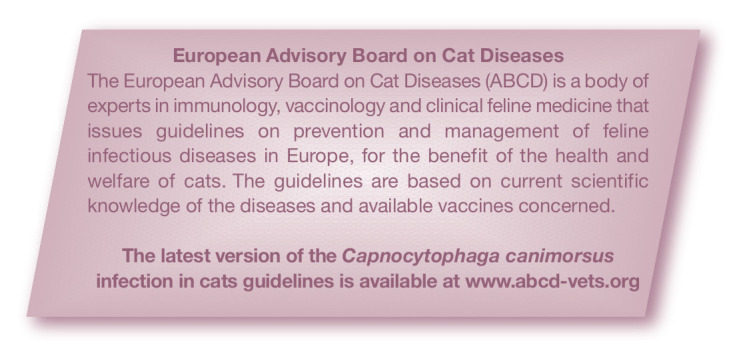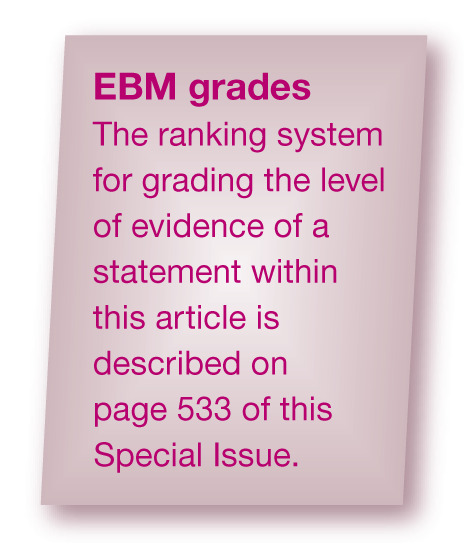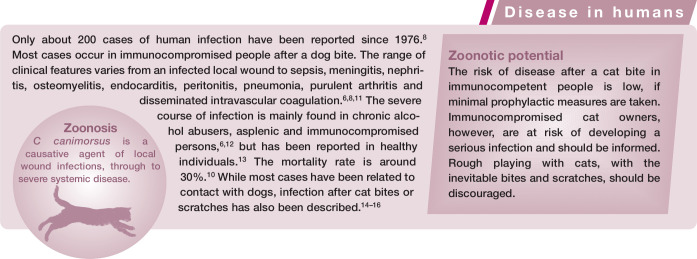Abstract
Overview:
Capnocytophaga canimorsus and Capnocytophaga cynodegmi are part of the normal bacterial flora of the oral cavity of dogs and cats. C canimorsus is more pathogenic and causes more severe infections in humans.
Infection:
Disease is less frequently seen after a cat bite, scratch or close contact than after dog contacts. Serious disease has been reported in people, especially associated with immunocompromise and alcoholism. Disease in cats is not well documented; two cases of respiratory infection have been associated with the presence of these bacteria.
Diagnosis:
Diagnosis is based on culture in specific media, but these are slow growing bacteria; polymerase chain reaction and sequencing may aid in diagnosis and species identification.
Treatment:
Penicillin or beta-lactams are the treatment options of choice.
Zoonotic potential:
Based on incidence surveys, the zoonotic potential is low. The risk may be higher for immunocompromised persons, where dog and cat ownership must be discussed.
Bacterial properties
Capnocytophaga canimorsus is a fastidious, slow-growing, capnophilic, facultative anaerobic, Gram-negative, rod-shaped bacterium displaying gliding mobility that belongs to the normal flora of the oral cavity of dogs and cats.1,2 Another species, Capnocytophaga cynodegmi, is also present in the normal flora. 3 Both can cause wound infections in humans after a bite, C canimorsus being associated with more severe infections. 3
Epidemiology and pathogenesis
C canimorsus was first cultured in 1976 from the blood and spinal fluid of a dog-bite patient, hence its name (canis = dog, morsus = bite). Infections occur worldwide. Many dogs and cats carry C canimorsus in their oral cavity. In one study, C canimorsus was cultured from 26% of dogs and 15% of cats sampled. Using a species-specific polymerase chain reaction (PCR) that distinguishes between C canimorsus and C cynodegmi, much higher prevalences were found in Japan; the former species was detected in 74% of the dog and 57% of the cat samples. 4 In the Netherlands, a recent survey documented C canimorsus in 21% of the cats. 5

Human infections with C canimorsus are associated with dog and cat bites (54%), scratches (8.5%) or close animal contact (27%). 6 One case of keratitis reportedly followed a corneal injury caused by a fractured cat’s tooth during extraction. 7 Cat bites and scratches or contact with cats have been reported in fewer than 10% of cases. 6 In general, cat bites cause less tissue damage than dog bites, which might create less favourable conditions for bacterial growth. 8
Capnocytophaga species infection is quite uncommon after dog and cat bites. In surveys from Denmark and the Netherlands, a yearly incidence of sepsis due to C canimorsus was calculated to be 0.5 and 0.63 per million population, respectively.9,10
Clinical presentation
Capnocytophaga species infections after bite traumas have not been reported in cats, and only two cases of a possible pathogenic role of the bacterium have been documented. In one instance, Capnocytophaga species was isolated from a case of chronic sinusitis and rhinitis, and – based on DNA sequencing – a strain closely related to C canimorsus and C cynodegmi was identified from nasal discharge. Since no other causes for chronic nasal discharge were found, the role of Capnocytophaga species was considered likely. 17 Another case report describes the isolation of C cynodegmi from bronchoalveolar lavage samples from a cat with lower respiratory tract infection and pulmonary carcinoma. Clinical signs and bacterial colonisation resolved after treatment with enrofloxacin. 18
Diagnosis
In humans, diagnosis of a C canimorsus infection is usually based on bacterial culture of blood or other body fluids; isolation from bite wounds is rare. The bacterium grows slowly on special media (chocolate agar or heart infusion agar with 5% rabbit blood, incubated in a 5% CO2 atmosphere). 6 PCR methods can distinguish between C canimorsus and C cynodegmi. 4
Treatment and prevention
In humans, the first choice antibiotic is penicillin G or potentiated penicillins as amoxicillin–clavulanate acid. Immediate cleaning and disinfection of bite wounds and scratches is important, as is antibiotic prophylaxis [EBM grade III].8,11

Footnotes
Funding: The authors received no specific grant from any funding agency in the public, commercial or not-for-profit sectors for the preparation of this article. The ABCD is supported by Merial, but is a scientifically independent body.
The authors do not have any potential conflicts of interest to declare.
Key Points
Capnocytophaga species are present in the normal oral flora of dogs and cats.
Disease in humans is more often associated with dog bites or contact than with those of cats.
While disease in humans is rare, mortality can be high in immunocompromised individuals if septicaemia occurs.
Immunocompromised cat owners need to be alerted to the risk of bite or scratch wounds and the consequent bacterial infections.
References
- 1. Blanche P, Bloch E, Sicard D. Capnocytophaga canimorsus in the oral flora of dogs and cats. J Infect 1998; 36: 134. [DOI] [PubMed] [Google Scholar]
- 2. Dolieslager SM, Riggio MP, Lennon A, Lappin DF, Johnston N, Taylor D, et al. Identification of bacteria associated with feline chronic gingivostomatitis using culture-dependent and culture-independent methods. Vet Microbiol 2011; 148: 93–98. [DOI] [PubMed] [Google Scholar]
- 3. Brenner DJ, Hollis DG, Fanning GR, Weaver RE. Capnocytophaga canimorsus species nov (formerly CDC group DF-2), a cause of septicemia following dog bite, and C cynodegmi species nov, a cause of localized wound infection following dog bite. J Clin Microbiol 1989; 27: 231–235. [DOI] [PMC free article] [PubMed] [Google Scholar]
- 4. Suzuki M, Kimura M, Imaoka K, Yamada A. Prevalence of Capnocytophaga canimorsus and Capnocytophaga cynodegmi in dogs and cats determined by using a newly established species-specific PCR. Vet Microbiol 2010; 144: 172–176. [DOI] [PubMed] [Google Scholar]
- 5. Lipman L, Tienhoven N, Gaastr W. The presence of Capnocytophaga canimorsus and Capnocytophaga cynodegmi in companion animals in the Netherlands. Tijdschr Diergeneeskd 2011; 136: 490–492. [PubMed] [Google Scholar]
- 6. Lion C, Escande F, Burdin JC. Capnocytophaga canimorsus infections in human: review of the literature and cases report. Eur J Epidemiol 1996; 12: 521–533. [DOI] [PubMed] [Google Scholar]
- 7. Chodosh J. Cat’s tooth keratitis: human corneal infection with Capnocytophaga canimorsus. Cornea 2001; 20: 661–663. [DOI] [PubMed] [Google Scholar]
- 8. Gaastra W, Lipman LJ. Capnocytophaga canimorsus. Vet Microbiol 2010; 27; 140: 339–346. [DOI] [PubMed] [Google Scholar]
- 9. Van Dam AP, Jansz A. Capnocytophaga canimorsus infections in The Netherlands: a nationwide survey. Clin Microbiol Infect 2010; 17: 312–315. [DOI] [PubMed] [Google Scholar]
- 10. Pers C, Gahrn-Hansen B, Frederiksen W. Capnocytophaga canimorsus septicemia in Denmark, 1982–1995: review of 39 cases. Clin Infect Dis 1996; 23: 71–75. [DOI] [PubMed] [Google Scholar]
- 11. Oehler RL, Velez AP, Mizrachi M, Lamarche J, Gompf S. Bite-related and septic syndromes caused by cats and dogs. Lancet Infect Dis 2009; 9: 439–447. [DOI] [PubMed] [Google Scholar]
- 12. Janda JM, Graves MH, Lindquist D, Probert WS. Diagnosing Capnocytophaga canimorsus infections. Emerg Infect Dis 2006; 12: 340–342. [DOI] [PMC free article] [PubMed] [Google Scholar]
- 13. Hantson P, Gautier PE, Vekemans MC, Fievez P, Evrard P, Wauters G, et al. Fatal Capnocytophaga canimorsus infection in a previously healthy woman. Ann Emerg Med 1991; 20: 93–94. [DOI] [PubMed] [Google Scholar]
- 14. Mahrer S, Raik E. Capnocytophaga canimorsus septicemia associated with cat scratch. Pathology 1992; 24: 194–196. [DOI] [PubMed] [Google Scholar]
- 15. McLean CR, Hargrove R, Behn E. The first fatal case of Capnocytophaga canimorsus sepsis caused by a cat scratch. J R Nav Med Serv 2004; 90: 13–15. [PubMed] [Google Scholar]
- 16. Valtonen M, Lauhio A, Carlson P, Multanen J, Sivonen A, Vaara M, et al. Capnocytophaga canimorsus septicemia: fifth report of a cat-associated infection and five other cases. Eur J Clin Microbiol Infect Dis 1995; 14: 520–523. [DOI] [PubMed] [Google Scholar]
- 17. Frey E, Pressler B, Guy J, Pitulle C, Breidtschwerdt E. Capnocytophaga sp isolated from a cat with chronic sinusitis and rhinitis. J Clin Microbiol 2003; 41: 5321–5324. [DOI] [PMC free article] [PubMed] [Google Scholar]
- 18. Forman MA, Johnson LR, Jang S, Foley J. Lower respiratory tract infection due to Capnocytophaga cynodegmi in a cat with pulmonary carcinoma. J Feline Med Surg 2005; 7: 227–231. [DOI] [PMC free article] [PubMed] [Google Scholar]



